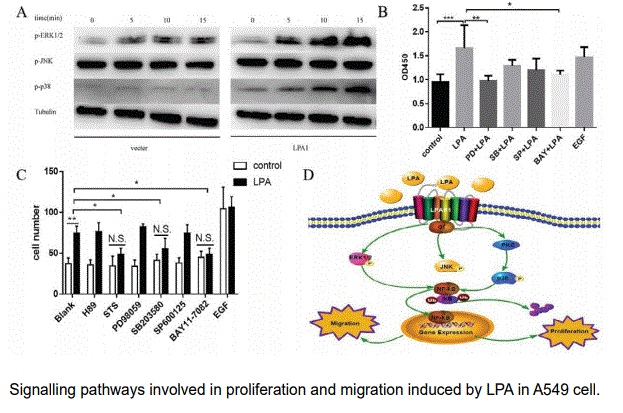5th International Conference on Oncology & Virology
July 25-26, 2019 | Holiday Inn Rome Aurelia, Rome, Italy
LPAR1: A Potential Therapeutic Target Molecule for Human Lung Cancer
School of Life Sciences, Inner Mongolia University, China
Lysophosphatidic acid (LPA) as a bioactive lipid exhibits a variety of physiological and pathological roles via activation of six types of G-protein-coupled LPA receptors (LPAR1–6). Our preliminary study found that LPAR1 highly expressed in lung cancer tissues compared with paracancerous tissues, but the role of LPAR1 in lung carcinoma is unclear. This study aimed to elucidate the association between LPAR1 and lung tumour behavior at the cellular and animal model levels. We found that LPA promoted the migration, proliferation and colony formation of lung cancer cell line (A549 cell). LPAR1 and LPAR3 preferentially expressed in A549 cell and both Ki16425 (antagonist for LPAR1 and LPAR3) and ONO7300243 (LPAR1 antagonist) completely blocked LPA-induced actions. The results were further verified by experiments in LPAR3 and LPAR1 over expressing A549 cells. Furthermore, the LPAR1 transgenic A549 cell was used in the study related to in vivo tumour-bearing animal model and the mechanism involved in LPA-induced actions. As results, the LPAR1 transgenic A549 cell - derived tumour volume significantly increased in animal model suggesting the LPAR1 is a regulator for in vivo tumour formation. Our results also proved that LPAR1 /Gi /MAP Kinases/NF-κB pathway involved in LPA-induced oncogenic actions in A549 cell. Thus, targeting of LPAR1 may be a noval strategy for the treatment of lung carcinoma.
Keywords: LPA receptor1 antagonists; lung cancer; in vivo tumourigenesis; signalling pathway

Biography:
Alatangaole Damirin is a Professor of biochemistry and molecular Biology at School of Life Sciences, Inner Mongolia University, China. He worked as assistant professor at Institute for Molecular and Cellular Regulation, Gunma University, Japan. He graduated from School of Medicine Gunma University, Japan. His Ph.D. major was on Molecular and Cellular Regulation. The aim of his research group is to elucidate the receptor mediated signal transduction mechanisms of lipid mediators, such as S1P and LPA and their roles in several disorders especially atherosclerosis and cancer. Their research is also centered on the role of proton-sensing GPCRs under acidic microenvironment trying to unlock their mysterious veil.


